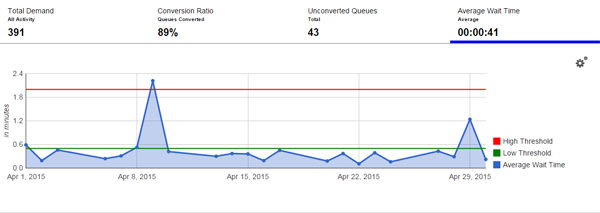The Comprehensive Guide to Live Chat for 2015 - for readers of all levels

My goal is for this article to be the only guide you'll need on live chat for the next 6-12 months (and hopefully it will still retain some value after that!).
I will start with the type of "3 Quick Tips" posts you're used to seeing from content marketing folks, then get a little more detailed for those with more time and interest, and finally dig into the real nitty-gritty for those who are ready to excel.
If you read this article's headline on this day in 2004, you'd probably laugh and get back to reading Yahoo News on your computer and texting on your flip phone, or if you were fancy your BlackBerry. Live chat for business was not well-received in its early days, for a number of reasons - but the reasons why it struggled for widespread adoption then are less important than the reasons why live chat is a must-have now.
Today, literally tens of thousands of businesses around the world rely on live chat software to help them to better engage their customers and other website visitors, to increase online sales conversions, to improve the efficiency of customer service teams, and to strengthen their brand. Organizations have seen increases of more than 20% in their online conversions by implementing live chat, and that's just within their first 30 days of use.
Already, those businesses that have found value in live chat are looking to squeeze even more value from it. Why? Because savvy consumers know it's there to be had, and because savvy business leaders are all about increasing their ROI.
3 Quick Tips to Make You a Live Chat Rock Star
You don't have time, and neither do your site visitors-that's why they want to engage with your chat agents directly. How can you get the most out of that interaction? Here's 3 quick tips to help make your company live chat rock stars.

(image courtesy of DeviantArt user Microkey)
1) Have quality pre-made messages or knowledge base references on-hand
There's no better way to provide an excellent customer experience than to respond immediately, accurately and politely to a customer's questions.
2) Pay attention to visitor activity on the site while engaged in chat
You can increase sales conversions (and gain valuable intelligence) by adjusting your interactions based on what pages visitors navigate to during their chat with you, offering to automatically "push" them to the page they're looking for, and "holding their hand" through the checkout process.
3) Utilize your live chat software's management-related functions
This will make you a rock star internally, by optimizing your team's efficiency. Scale team size based on seasonal or daily surges and lulls in chat activity, assign or escalate conversations to the right agents, etc.
Rock on!
The Dollar Tour of ROI for Live Chat Software
If you're already using a live chat software solution, there are five advanced features you will want to familiarize yourself with before you try to master any other advanced features (though be sure to check out the "3 Quick Tips" above for some basics before getting into the more advanced items below).
If you haven't yet chosen a product or provider for your online live chat, you should keep these same five features at the top of your list as you explore your options.
Five Advanced Features Essential to Maximizing Live Chat ROI
These are the features that correlate most strongly with the continuous improvement of your live chat software ROI:
1. Integration
2. Proactive chat
3. Customization
4. Reporting
5. Customer Success Management (this is not a feature per se but it's an equally important consideration where ROI is concerned)
Success Management
Let's start from the last item on the list, success management, and work up from there. You need to investigate what your current (or prospective) provider offers, not merely in terms of tech support but also in terms of sharing best practices. There may be luminaire customers they can put you in touch with, resources they can recommend, or advanced training they can offer to better equip you to succeed.
It doesn't hurt to ask, especially as many companies don't prioritize making these types of programs well known to their existing customers!

("Customer success program" may be the 'magic word' you need to use to get access to your live chat provider's VIP resources.)
Reporting
Reporting is arguably the most important feature a live chat software package can provide to maximize your ROI. Reporting is not only useful for holding your team accountable and proving their hard work but it's also the tool that's going to drive all future improvements.
Your live chat reporting should provide sufficient, relevant data such that it can inform changes to customer service and live chat processes. In the case of customer service, this might have to do with word choice (A/B testing premade messages) or escalation flow (routing procedure). In terms of live chat, this might have to do with identifying on what pages to invite a visitor to chat, what the invitation looks like, what triggers its display, etc.
You can read more about specific indicators to look for in your live chat reporting by clicking the image below.
Customization
Customization simplifies the process of making changes (or in some cases, makes making changes possible at all).
When your live chat reporting (see above) tells you that you need to change the way your invitation to chat looks, customization is what lets you make those changes on your own, rather than having to spend time with tech support and/or money with a services team. The better the customization tool, the more quickly and easily you can make those changes.
What should you expect to be able to customize on your own?
You should be able to create a chat invitation of any size, with any design, and/or appearing after any length of time you specify. All of these options can vary from page to page, so maybe you want something immediate and gigantic to pop-up on a blog page but something that looks like an active chat window that opens after 3-5 seconds of inactivity on a shopping cart page.
You should also be able to customize what your pre-chat survey looks like, if you decide to use one (which you should strongly consider, as it can be helpful for reporting purposes and lead nurturing, as well as for directing a site visitor to the department or chat agent best equipped to help them).
Proactive Chat
Although leaving a "click here to chat" button on your website and hoping for the best is actually an appropriate strategy for some situations, the vast majority of companies are going to benefit from proactive chat in one form or another. Rather than waiting for the customer to click a static button on your site, proactive chat extends the invitation to the visitor.
What does this have to do with ROI? 44% of online consumers believe having their questions answered by a live rep in the middle of an online purchase is one of the most important features a website can offer.
Even without reporting and customization, proactive chat is valuable - but when coupled with robust reporting and complete customization, you have the intelligence and the autonomy you need to perfect your live chat invitations and maximize your conversion rate.
That's when proactive chat becomes the onramp to high-velocity live chat ROI.
Integrations
In terms of ROI, integrations are not about increasing revenue so much as decreasing cost.
Many companies who have implemented live chat software suffer from a limited ROI because of the new operational hurdles introduced by simultaneous use of live chat with other software systems. For instance…
The live chat transcripts don't automatically attach themselves to records in the CRM or help desk/ticket management software, adding time and additional human error to the documentation process.
The live chat data isn't automatically correlated with purchasing information from the e-commerce platform, making zeroing in on ROI from live chat time-consuming, manual work.
The engagement data from Google Analytics isn't automatically connected to data about missed chats, surges and lulls in chat activity, or visitors clicking the chat button vs other calls to action on a given webpage, limiting your ability to improve the effectiveness of live chat without significant supplemental research and effort.
Without key integrations in place, these several extra steps can offset a significant amount of the return you can normally anticipate capturing from investing in a live chat solution.
Ask your (prospective) live chat vendor what integrations are available, and consider going one step further and asking about integrations they may not have initially mentioned. For instance - do your chat agents also answer phones? It might be valuable to ask about an integration that would prevent inbound calls from being directed to reps already engaging in one or more chats, and vice-versa.
Of course, always ask how much extra cost each integration represents and do your due diligence by having your vendor put you in touch with a customer who is actively using the integration. Ask specifically: how happy are they with the integration and what should you expect from it? You'll kick yourself for implementing if you don't.
Passing the Hat

Was that worth a dollar? Thank us with a tweet instead. Tweet: You should read and tweet this "dollar tour" of ROI for online chat software; it exceeded my expectations https://ctt.ec/2advc+
Roll Up Your Sleeves and Get Into the Guts of Live Chat
Hopefully the first two sections have primed you for a deeper conversation about how live chat itself will be the best tool you can use to improve your ROI from live chat. With a better understanding of integrations, proactive chat, customizations, reporting and customer success management, and orienting yourself towards high-quality messages, visitor monitoring and management-level functionality, you are ready to increase conversions, customer engagement and team efficiency. Let's get started!
The Vital Organs of Live Chat ROI
Reporting and customization form the cycle by which your organization will continuously refine and disseminate uniquely specific best practices, and identify and segment out less effective practices. This process, performance management, empowers you to continuously and simultaneously improve your effectiveness and your efficiency as a customer service organization.
According to Aberdeen Research, approximately half of companies using live chat have a formal program in place to this effect. These companies are nearly twice as likely to increase annual revenue as their less savvy counterparts who utilize live chat without performance management. These "savvy users" are 55% more likely to effectively reduce repeat customer contact (this is related to first contact resolution and average handle time) while simultaneously being 5 times more likely to reduce customer contact abandonment rate. Crazy, right?
Utilizing performance management within live chat programs is clearly very healthy for a business, so why isn't every company doing it?
The Four Humors
Ancient medicine maintained that the body was governed by the interactions of black bile, yellow bile, phlegm and blood. Blood, produced by the liver, sloshed around the body, causing a courageous, hopeful, carefree temperament. A preponderance of phlegm, which covers fluids from mucus to saliva to other interstitial fluids, causes calmness and patience. Imbalances in any of the humors could be repaired with bloodletting (by use of leeches, for instance), and induced sweating and/or vomiting. For over 2,000 years, this was the predominant way of thinking about the human body and how to restore health when it was ailing. Only in the last 150 years has humorism been conclusively abandoned by the medical field.
Performance management in live chat is still relatively new. Data can be intimidating, especially if you have had no real practice collecting and interpreting it. And change is often threatening; it challenges the ways that are familiar to us, and even can make us feel like antiquated, obsolete or even detrimental elements in our organizations.
So why would any organization ever want to implement a process of continuous change like performance management?
In Pursuit of Excellence
When presented with the possibility that we are not achieving our potential, it can be tempting to stick our head in the sand, protecting our ego until the source of the criticism is gone. However, when that happens, and when you finally pull your head out of the dirt, you find that your competition has been running with their heads up and their eyes forward the entire time.
In my experience, organizations that foster cultures of learning, growth, improvement, and innovation find great value in adhering to performance management practices. If that sounds like you or like what you aspire to be, here's what your organization needs to know in order to successfully implement performance management practices within your live chat program:
1) Start small
2) Gather data early and often
3) Think long-term and short-term
4) Test frequently when you can, but always test meaningfully
Start Small
Pick one key metrics to start. Sound basic? Sometimes that's the best way to start.
("Wiggle your big toe.")
Tracking agent utilization and/or surges and lulls in visitors using live chat by time of day, day of the week, and/or season might be a helpful place to start.
In terms of ROI, this won't directly help you increase revenue (except in the sense that you're less likely to miss opportunities from impatient, frustrated visitors), but it will help you increase efficiency, which is a great early win for demonstrating live chat ROI to yourself, your team and your boss(es).
Not surprisingly, Aberdeen found "savvy users" had utilization rates that were 30 percentage points better than their peers who utilized live chat without performance management practices in place. That's ROI!
Gather Data Early and Often
Your business is unique. Industry and global trends can be useful for a general, fuzzy sense of what to expect, but when it comes to self-improvement through performance management, you will eventually need to get scalpel-specific.
When you have an idea for a process improvement, determine what metrics are going to be relevant for evaluating whether that "improvement" actually made a positive impact or not (pro-tip: you may also want to consider what metrics are relevant for determining what negative trade-offs that intended improvement may create).
Once you've identified those metrics, begin collecting data prior to actually making the change - this baseline data will allow you to come to a more meaningful conclusion about whether the intended improvement is perfect "as is" or-more likely-whether it needs some additional tweaking before it qualifies as "best practice" for your organization.
For example, if you're considering implementing proactive chat on your homepage (a really great question to consider!), you probably want to establish at least a month of baseline data on:
• what fraction of visitors engage via your static "click here to chat" button
• what visitor chat satisfaction scores look like
• what results, relevant to your business, chat interactions on your homepage yield (sales, first contact resolution, etc.), and
• what your bounce rate is for the page.
In this instance, the data will likely be informative within a week or two after implementing a proactive chat invitation on your website.
With a bit of refining and a bit more time (see testing below), you'll be able to more conclusively determine 1) whether proactive chat is worthwhile for your organization or not 2) where and when to launch a proactive chat invitation, and what that invitation should look like 3) what types of site visitors are more responsive to what types of proactive chat invitations.
Think Long-Term and Short-Term
Performance management applies in real-time, for instance by directing chats in a contact center based on agent availability and expertise, but it also applies on a bigger timetable, for instance by helping to identify common characteristics of high-performing agents which can be used to inform future recruiting and training efforts.
When implementing performance management within a live chat program, consider what data-points can support both immediate and long-term applications. For instance, it could be valuable to track average handle time and customer satisfaction data - this will tell you in the moment which agents are the most efficient (and/or who needs the most coaching) as well as shed some light more broadly on where the balance can be found between efficiency and customer satisfaction.
Thinking at both levels accomplishes two purposes:
1) it minimizes the number of data points you need to pay attention to, as the same data can be used for multiple purposes
2) it helps you relentlessly pursue real improvement (maximizing your ROI), by thinking about the ultimate goal without ignoring your immediate challenges
Test Frequently When You Can-But Always Test Meaningfully
Performance management doesn't work if you only collect data but never make changes based on that data.
A/B testing is a popular method for achieving this, whereby you present two versions of the same thing and determine which performed better and why. The most obvious implementation of this in live chat software is in the premade messages agents use while talking with site visitors. Whether it's something as seemingly trivial as using "hi" versus "hello" or something more obviously controversial like trying to sell/upsell versus merely answer questions, A/B testing is an excellent way to determine how to make your best efforts even better just as a natural part of the process of using live chat software.
The key is to test again and again, ensuring that you are truly giving customers the best experience you could possibly offer.
Subscribe to Our Newsletter!
Latest in Marketing










